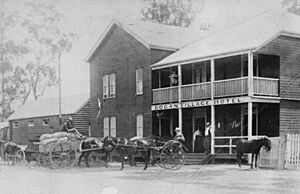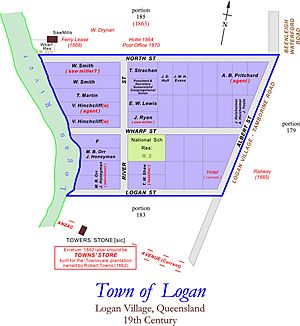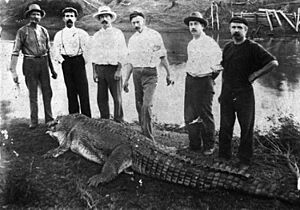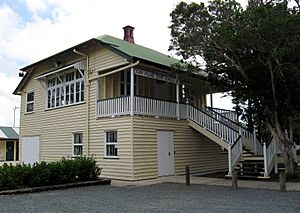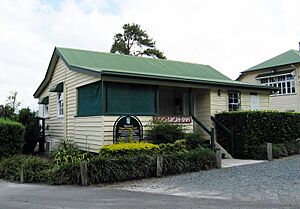Logan Village, Queensland facts for kids
Quick facts for kids Logan VillageLogan City, Queensland |
|||||||||||||||
|---|---|---|---|---|---|---|---|---|---|---|---|---|---|---|---|
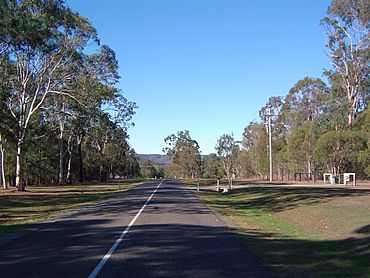
Hotz Road, 2014
|
|||||||||||||||
| Population | 5,316 (2021 census) | ||||||||||||||
| • Density | 134.58/km2 (348.6/sq mi) | ||||||||||||||
| Postcode(s) | 4207 | ||||||||||||||
| Area | 39.5 km2 (15.3 sq mi) | ||||||||||||||
| Time zone | AEST (UTC+10:00) | ||||||||||||||
| Location |
|
||||||||||||||
| LGA(s) | Logan City | ||||||||||||||
| State electorate(s) | Logan | ||||||||||||||
| Federal Division(s) | Wright | ||||||||||||||
|
|||||||||||||||
Logan Village is a cool semi-rural town in Queensland, Australia. It's part of Logan City. Long ago, it was important because boats could travel up the Logan River to this spot. Later, when the railway came, the town became even more important!
In 2021 census, about 5,316 people lived in Logan Village.
Contents
Discover Logan Village
Logan Village is a spread-out, country-style area. It doesn't have many big shops or businesses. The Logan River flows right through the middle of the town. You can also see the old Beaudesert railway line here, which isn't used anymore. The main road, Waterford-Tamborine Road (State Route 95), also runs through the town from north to south.
The town gets its name from the Logan River. The river was named by Ralph Darling, who was the Governor of New South Wales, after Captain Patrick Logan. In the past, people called the town different names like Village of Logan or Town of Logan.
A Look Back in Time
Early Explorers and Settlers
In 1827, Captain Patrick Logan, who was in charge of the Moreton Bay penal colony, explored the area. He camped by the Logan River near where Logan Village is today. He wrote in his diary that the river was too deep to cross.
On an old map from 1842, the Logan River is marked to show how far boats could travel up it. This spot was close to Logan Village.
At first, free settlers weren't allowed to live near the penal colony. But after 1842, when the colony closed, land became available. The first Europeans came to the area to cut down valuable cedar trees.
Logan Village became a settlement because it was the furthest point boats could reach on the Logan River. In 1862, land was set aside for farming. The first buildings were a wharf and a store. These were used by a big cotton farm called ‘Townsvale’.
Growing the Town
In 1863, the farming area around Logan Village grew even bigger. A plan from that year shows the town as a special reserve of about 47 acres. The town was officially surveyed in 1865, with lots of about 1 acre each.
First Church and School
The Logan Village Congregational Church opened on December 24, 1871. It was a special day for the community.
The first school, called the Village of Logan Provisional School, opened on February 1, 1872. It later became Logan Village State School in 1901. In 1981, the school moved to a new location. The old school building is now a heritage site and used by the community.
Railways and Bridges
The Beaudesert railway line reached Logan Village on September 21, 1885. This made the town even more important for transport. The railway station was called Logan Village railway station.
The first bridge over the Logan River in Logan Village was built in 1897. But a flood washed it away in 1903. It took 93 years for a new bridge to be built in 1996! This new bridge was named after Geoff Philp, a local engineer.
Another railway line, the Canungra railway line, was built from Logan Village to Canungra. It opened in 1915 but closed in 1955.
The Logan River Crocodile
In June 1905, something amazing happened! A dead crocodile was found in the Logan River near Logan Village. People had heard stories of a crocodile in the river, but many didn't believe it. Crocodiles usually don't live south of the Mary River.
A man named Charlie Gottch had shot at it a few days earlier, and it disappeared. Then, it was found dead at Logan Village. It was a huge crocodile, about 12 feet 7 inches long! People thought it might have been a crocodile that escaped from Brisbane nine years before. The crocodile's skin was kept at the Logan Village State School for many years.
World War II and Modern Times
In the 1920s, there was a rifle range for the Logan Village Rifle Club.
During World War II, a large army training base called Camp Cable was located near Logan Village. Today, memorials for the camp are at the Logan Village RSL.
Logan Village used to be part of the Shire of Beaudesert. But in 2008, it became part of Logan City.
In 2013, Logan Village celebrated Settlers Day. This marked 150 years since the first land was settled there. There was a parade, a re-enactment of Captain Logan's landing, and other fun activities. An "outdoor museum" called the Forest of Memories was also created. It has plaques and tall totems with old photos and stories from the area.
Learning in Logan Village
Logan Village State School is a primary school for students from Prep to Year 6. It's located on North Street. In 2018, about 691 students attended the school. It also has a special education program.
There isn't a high school right in Logan Village. Students usually go to Yarrabilba State Secondary College in nearby Yarrabilba, or other high schools like Marsden State High School in Waterford West.
Community Life and Fun
Local Facilities
The Logan Village Cemetery is a quiet place on the corner of Waterford–Tamborine Road and Pioneer Drive. It's looked after by the Logan City Council.
The Logan Village Rural Fire Brigade Service and the SES Facility are also in the area. These groups help keep the community safe.
Community Hubs
The Logan Village Community Centre is a busy place! It's located at the old Logan Village State School site. The Logan City Council runs a public library in the old school master's house. The old school building from 1902 can be rented for meetings.
Many other historic buildings have been moved to this site to create a special village feel:
- Colonel Ferguson Cottage: Now a meeting place.
- Doo Drop Inn: Now called the Craft Cottage.
- Dance Hall: This old building is now a museum that shows farm tools and machinery.
- Fettlers Cottage: Another museum building.
- Railway hut: Also a museum building.
Next to the Community Centre is the Village Green. It's a lovely park with picnic spots and a playground.
Parks and Recreation
Logan Village has several other parks where you can relax and play:
- Big River Country Park: Great for different sports.
- Logan Village Park: A natural bushland area.
- Merv And Ollie Musch Park: Home to the Logan Village RSL and Logan Village Riding Club.
- Quinzeh Creek Park: Another beautiful bushland area.
- Towns Avenue Park: Located right beside the Logan River.
If you like golf, there's the Village Links Golf Club. It's an 18-hole golf course.
Places to Visit
The Logan Village Museum is a great place to learn more about the town's history.
The Logan Village War Memorial is a special place to remember those who served.
Famous Faces
- Thomas Plunkett: A dairy farmer and politician who lived here.




